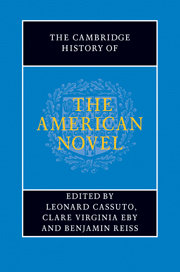Book contents
- Frontmatter
- General Introduction
- PART ONE INVENTING THE AMERICAN NOVEL
- PART TWO REALISM, PROTEST, ACCOMMODATION
- Introduction: realism, protest, accommodation
- 17 Realism and radicalism: the school of Howells
- 18 James, pragmatism, and the realist ideal
- 19 Theories of the American novel in the age of realism
- 20 The novel in postbellum print culture
- 21 Twain, class, and the Gilded Age
- 22 Dreiser and the city
- 23 Novels of civic protest
- 24 Novels of American business, industry, and consumerism
- 25 New Americans and the immigrant novel
- 26 Cather and the regional imagination
- 27 Wharton, marriage, and the New Woman
- 28 The postbellum race novel
- 29 The African American novel after Reconstruction
- 30 The rise of naturalism
- 31 Imagining the frontier
- 32 Imperialism, Orientalism, and empire
- 33 The hemispheric novel in the post-revolutionary era
- 34 The woman's novel beyond sentimentalism
- 35 Dime novels and the rise of mass-market genres
- 36 Readers and reading groups
- PART THREE MODERNISM AND BEYOND
- PART FOUR CONTEMPORARY FORMATIONS
- A selected bibliography
- Index
30 - The rise of naturalism
from PART TWO - REALISM, PROTEST, ACCOMMODATION
Published online by Cambridge University Press: 28 July 2011
- Frontmatter
- General Introduction
- PART ONE INVENTING THE AMERICAN NOVEL
- PART TWO REALISM, PROTEST, ACCOMMODATION
- Introduction: realism, protest, accommodation
- 17 Realism and radicalism: the school of Howells
- 18 James, pragmatism, and the realist ideal
- 19 Theories of the American novel in the age of realism
- 20 The novel in postbellum print culture
- 21 Twain, class, and the Gilded Age
- 22 Dreiser and the city
- 23 Novels of civic protest
- 24 Novels of American business, industry, and consumerism
- 25 New Americans and the immigrant novel
- 26 Cather and the regional imagination
- 27 Wharton, marriage, and the New Woman
- 28 The postbellum race novel
- 29 The African American novel after Reconstruction
- 30 The rise of naturalism
- 31 Imagining the frontier
- 32 Imperialism, Orientalism, and empire
- 33 The hemispheric novel in the post-revolutionary era
- 34 The woman's novel beyond sentimentalism
- 35 Dime novels and the rise of mass-market genres
- 36 Readers and reading groups
- PART THREE MODERNISM AND BEYOND
- PART FOUR CONTEMPORARY FORMATIONS
- A selected bibliography
- Index
Summary
In “The Naturalism of Mr. Dreiser” (1915), the critic Stuart P. Sherman found nothing to praise in Theodore Dreiser's naturalism, which, Sherman complains, “drives home the great truth that man is essentially an animal” impelled by a “jungle-motive,” with protagonists that acquire not wisdom but “sensations.” Treating morality as an innate feature of human nature, Sherman singled out as unrealistic the idea that Dreiser's Jennie Gerhardt would feel not “sin or shame or regret” at bearing a child out of wedlock. He concludes that, unlike realism, which relies on a theory of human behavior, naturalism is “based upon a theory of animal behavior” and lacks the “moral value” and “memorable beauty” of true art. Naturalism had weathered similar charges of indecency, crudity, and a lack of decorum since its appearance on the American literary scene in the mid-1890s. Late nineteenth-century theories of Darwinian evolution had not only undercut the supposedly “natural” division between humans and animals but had also questioned the “natural” itself. Was morality “natural,” or love, or duty? Or were they all simply socially acceptable manifestations of human drives such as fear, desire, and self-preservation? Conservative critics like Sherman were understandably worried by the work of Dreiser and others like him, for American naturalism, in applying scientific principles to the medium of fiction, threatened to strip the conventional pieties from the façade of the social order.
- Type
- Chapter
- Information
- The Cambridge History of the American Novel , pp. 499 - 514Publisher: Cambridge University PressPrint publication year: 2011
- 1
- Cited by



